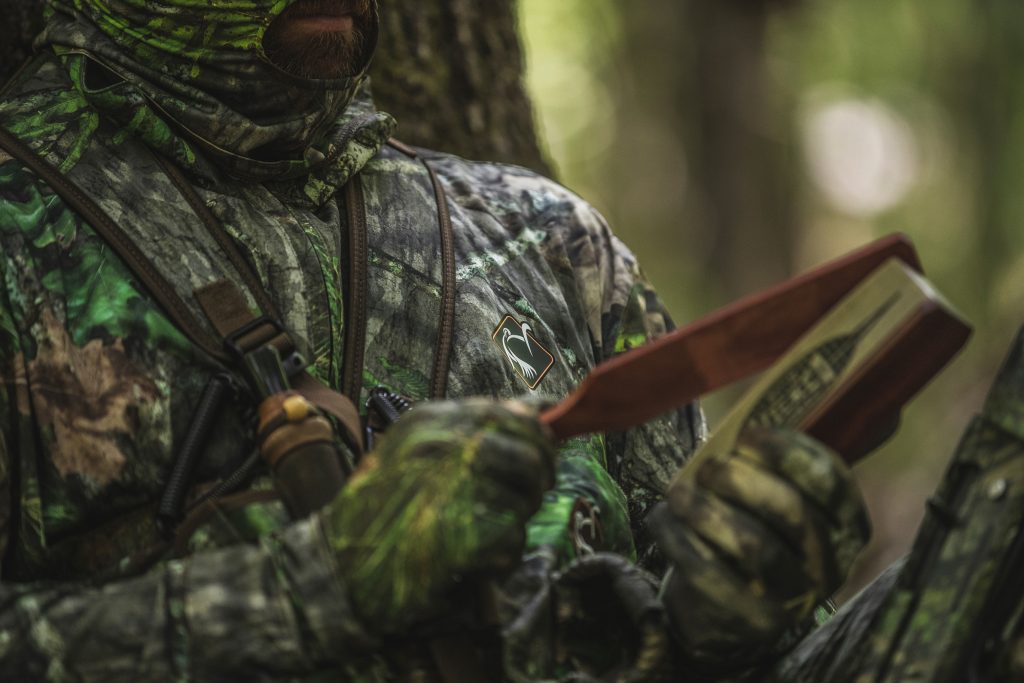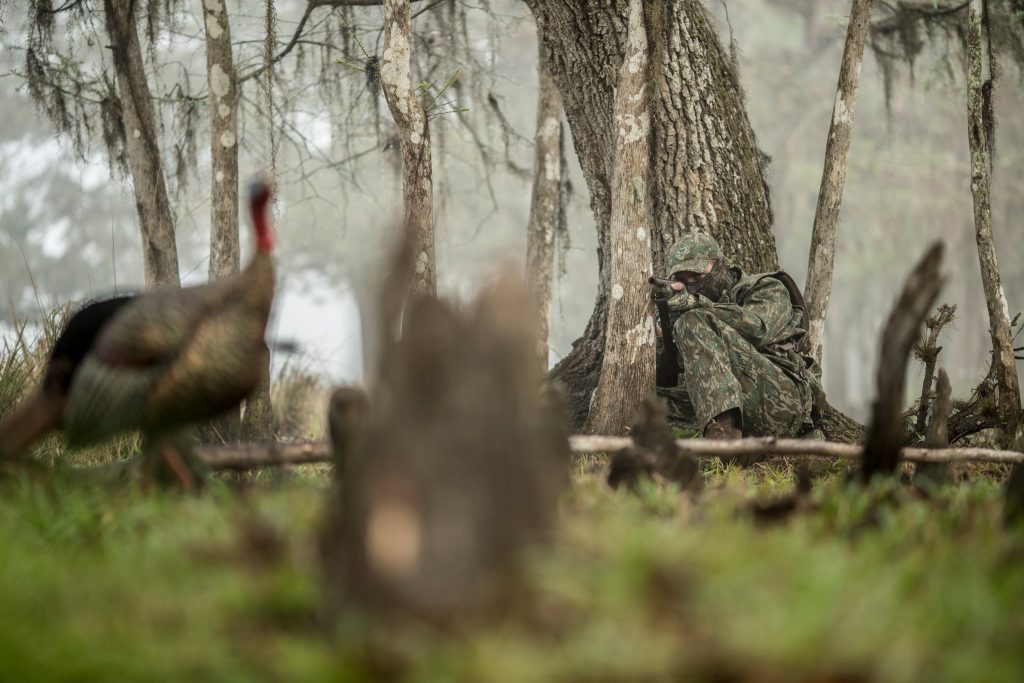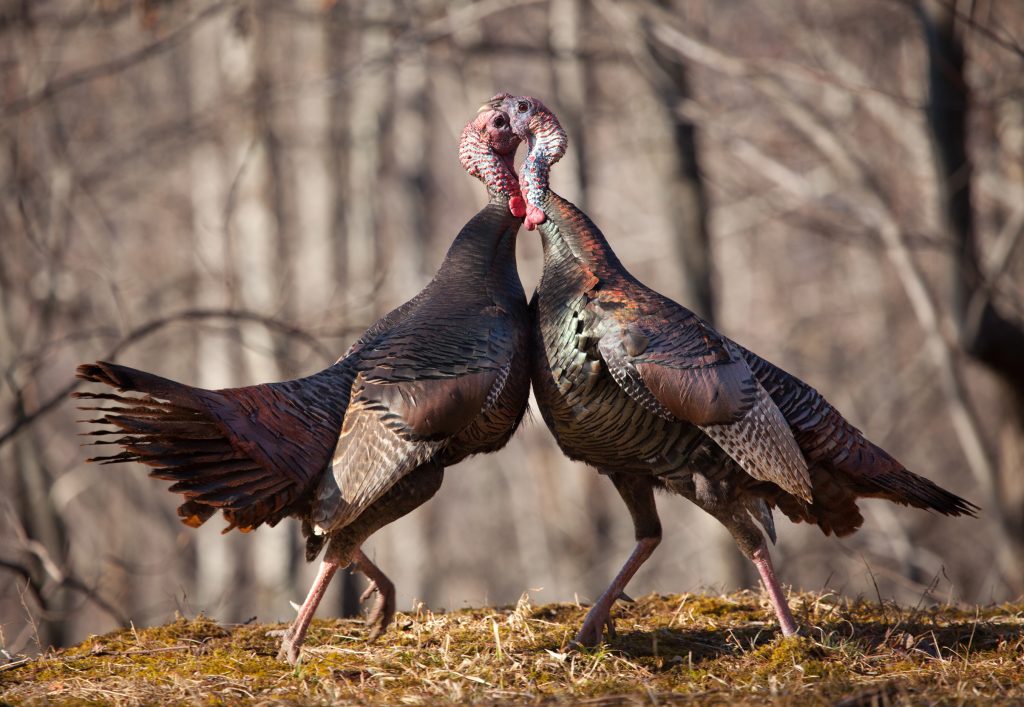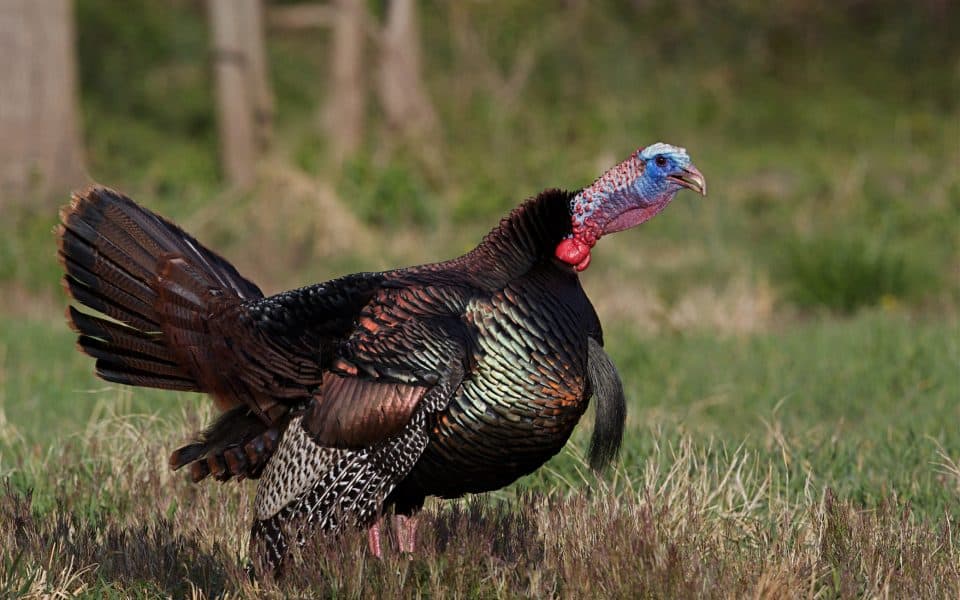The true essence of turkey hunting is the “call-up.” Sure, you can bushwhack a bird if you just need meat, but to call a big long beard into range should make any hunter proud. Understanding wild turkey vocalizations and knowing the right sound to use at the right time will make you a better turkey hunter.
Communication
Verbal or vocal communication consists of several components. One is vocabulary. Both parties involved in a conversation must understand the meaning of individual words or sounds. Next comes grammar, which Encyclopedia Britannica defines as: “Rules of a language governing the sounds, words, sentences, and other elements, as well as their combination and interpretation.” In order to be an effective communicator, one must put the proper words in some logical order to correctly convey the message. Then there’s tone and inflection. How you say something, whether it’s soft or loud, calm or excited, can sometimes change the meaning of what is being said. That all matters, whether you’re talking to another person, or a turkey.
There’s no substitute for experience. You learn vocabulary and grammar in school but people in cultures without written language still learn to be effective communicators simply by listening and observing. That’s also the best way to learn to talk turkey. However, a few basic lessons can help smooth the learning curve. Apologies in advance to the more proficient turkey linguists, but even you may pick up a tip or two.

Basic Wild Turkey Vocabulary
According to some sources, the wild turkey’s vocabulary consists of as many as 30 distinct calls. Fortunately, hunters need to only to know a half-dozen or so to hold a conversation. Like a good foreign language lesson, we’ll start with the basics and work up.
Part I: The Yelp
The yelp is the foundation of all turkey calling. It is the call most familiar to and most used by turkey hunters – in one form or another – to lure a bird. The basic yelp is a two-note call, beginning with a high-pitched kee and ending with a lower-pitched yuk, typically described as a kee-yuk or kee-yawk sound. To the normal ear, the kee and the yuk are blended together to sound almost like a single note, sometimes described as chalk.
Thinking of it as a two-note call is helpful in learning how to imitate it. With friction calls, start by exerting more pressure on your striker or paddle to get the kee, then ease up to get the yuk. Similarly, with diaphragms you press harder with your tongue to get the kee, then lower your tongue and drop your jaw to get the yuk. Practice until you get your kee-yuk right, then speed it up until it sounds more like a single-syllable kyuk. That’s the yelp.
Plain Yelp
The “plain yelp” is the most common call used by turkeys and turkey hunters. A typical rendition consists of repeating the yelp about four to seven times. If you can do this, you can kill a turkey – sometimes. Cadence is important and the best way to learn the right pulse and tempo is by listening to real turkeys, or recordings.
Tree Yelp

Sylvie Bouchard
The “tree yelp” is a muted, softer version, usually repeated only three or four times. As its name implies, it’s a sound turkeys make on the roost, typically as they first begin to stir in the morning, before fly-down. To imitate it, emphasize the yuk part of your yelp as softly and quietly as you can.
Assembly Yelp
The “assembly yelp” is similar to the plain yelp, only a bit more insistent and often longer – consisting of more notes (sometimes 20 or more yelps in one sequence). It’s used by the hen to gather or assemble her brood flock. Thus, it’s most often used for fall hunting. She’s saying, “C’mon guys and gals, let’s gather up. It’s time to move on.” It can also be given before the flock goes to roost for the evening.
Lost Yelp
The same is true for the “lost yelp.” It is slightly louder and lower in pitch than the plain yelp, and may be repeated as many as 30 times. Turkeys are gregarious creatures, particularly in the fall; and when they get separated, they get anxious. They’re saying, “Hey, is there anybody out there? Anybody at all? Hello! Somebody?”
Part II: The Cluck
Sometimes the yelp is sped up to the point where the kee is virtually indistinguishable, leaving only the yuk, or “cluck” – a short, sharp note that sounds just like its name. This cluck is used by turkeys, and turkey hunters, in a variety of ways, alone or in conjunction with other calls. It’s made on friction calls by either picking the surface of your slate with a peg, or striking your box sharply with the paddle. With a diaphragm, simply mouth the word cut, tut or hut.
You may hear a hen uttering single clucks at spaced out intervals as she feeds contentedly along. It’s also believed that like the yelp, turkeys use the cluck as a way for flock members to keep track of one another in thick cover. Again, we don’t know the actual meaning for sure; but we do know that by imitating the cluck, in its various configurations, you can make a turkey come closer to you. Some hunters will throw a few stray clucks in with their yelping to “dress” their calling. The cluck is also sometimes used along with the purr (see below) to create a cluck-and-purr.
Caution is advised here because the cluck, like the word “hey,” can have very different meanings depending on tone and inflection. Soft, spaced clucks might convey, “Hey, what’s up?” Sharp, loud clucks might mean, “Hey, what’s that? Danger!” Though still a cluck, the latter is sometimes referred to as a “putt” or “alarm putt.” It’s not one you want to mimic, but it’s good to know the meaning: the game is over and if you have a shot you’d better take it now.
Part III: The Cutt
The “cutt” is not actually a distinct call. Rather, it involves stringing together multiple, more excited clucks in rapid succession, which is called “cutting.” There are no hard and fast rules about how many clucks to use. You may use four or five, or you may use more depending on the situation, which we’ll discuss further down. This call may signal excitement or aggression.
When he’s in the right mood, you can really fire up a randy gobbler by cutting at him. When he’s not, you can do more harm than good; so it’s often best to error on the side of caution. Use it sparingly and conservatively unless you’re sure.
Cutting can also be used on hens, and caution is advised here as well. Cutting can excite a hen, prompting her to be more vocal, which might attract other birds. However, it could work against you. While the concept of a jealous hen is a bit anthropomorphic, a real hen might consider your cutting to be competition, and could try to draw her suitor away from you.
The cackle
Another variation of cutting is the “cackle” – some combination of excited cutts and yelps. The version most often used by turkeys and hunters is the “fly-down cackle,” intended to mimic a turkey flying from the roost. It starts out with short, rapid cutts, then tapers to longer, more drawn-out cutts as the bird nears the ground, sometimes ending in a few plain yelps when she hits the ground.

Part IV: The Purr
The “purr” might best be described as a tree yelp with a rattle or roll. It sounds like its name, and is also a relaxed or contented call. On friction calls, you make it by drawing the peg across the slate, or the paddle across the box more slowly. On a diaphragm, you purr by rolling your tongue while slowly exhaling.
A louder, more aggressive and prolonged variation is called the “fighting purr” or “rattle.” Like antler rattling for whitetails, it’s a sound that toms, jakes and even hens make when sparring, and sometimes works similarly to attract other birds. However, you might frighten off more birds than you call, so use this one sparingly.
As mentioned above, the purr is often combined with a cluck, to produce the cluck-and-purr (or purr-and-cluck). Though typically not loud or audible from a long distance, it’s a fairly common call made by relaxed hens. When toms are close, but not close enough, this call can bring them the rest of the way.
Part V: The Kee-Kee
Kee-Kee – To this point we’ve addressed mostly the “yukky” half of the yelp. The first half or kee, is also used separately, to make the kee-kee. Predominantly a call used during the fall, it consists of several short, high-pitched whistling notes, and is made by young birds that have not quite developed their adult voice. Poults may kee-kee any time, but become particularly vocal when separated from their flock.
While I know a few aficionados who can mimic it on a slate, this call is best performed on a mouth call. Press hard against the roof of your mouth to get a high-pitched tone while mouthing the words kee-kee-kee or pee-pee-pee.
As the young birds become older and more vocally adept, they may break from the high-pitched kee-kees into yelps. This is called a “kee-kee-run.” It’s kind of like a teenage boy whose voice cracks as he’s going through puberty. Though used predominantly in the fall, spring hunters will sometimes use the kee-kee to make a strutting or moving tom stop and stick his neck up, making for a better target.
Part VI: The Gobble
Every turkey hunter knows this one. It’s the sound that stirs the soul, makes our heart pound, our pulse quicken and our mouth go dry. This is the mating call of the male turkey. It’s used primarily to attract hens, though toms will often gobble in response to a loud noise.
It’s difficult to describe how, but it can be mimicked on a mouth or box call, or with a gobble-tube. The easiest way to gobble on a box call is by using a rubber band to hold the paddle tight, but not too tight. Hold the call in one hand and shake it back and forth. With practice, you can also use a two-handed method, swiping the paddle rapidly back and forth. Just keep practicing until it sounds like a turkey. This call is best used sparingly, especially when hunting public land or where other hunters are present, as it may attract more hunters than turkeys. If you’re certain you’re alone however, it can be effective. To a tom it may represent a challenge from a rival male.
Non-Turkey Sounds
Turkey calls aren’t the only sounds you might make over the course of a hunt. As noted above, toms are amped up in the spring and will sometimes respond to a loud noise. This response is referred to as a “shock gobble,” and is a way to make the gobbler give away his location without attracting him to your location, allowing you to move closer or get into a better position and prepared.
Probably the most common and popular locator call is the barred owl call, often used to locate a roosted tom the night before, or the morning of a hunt. To imitate it, give several successive hoots in a pneumonic cadence that goes: “who cooks for you; who cooks for y’all.” If you can’t do it with your voice, several commercial owl calls are available. While the full phrase sounds impressive, sometimes a single, drawn out “whooo,” works just as effectively.
A coyote howl will sometimes serve the same purpose, and may even work better in heavily-hunted areas where turkeys become conditioned to owl calling and won’t respond as readily. Other options include crow, peacock or woodpecker calls. A standard “caw, caw” might shock a bird, but they hear crows all day and it may be more effective to sound like a very excited crow.

Wild Turkey Conversations
Now that you are familiar with the vocabulary, let’s work on some composition and context for your conversations.
Lesson 1: Say Good Morning
You put a bird to bed last night with your owl calls, slipped in quietly under cover of pre-dawn darkness and set up within calling distance of your roosted bird. The inky eastern sky slowly turns a pinkish gray and from the roost come the first gobbles of dawn. It’s time to get acquainted.
Like most folks, I suspect, I’m not much for morning conversation until I’ve had a cup of coffee. I think turkeys are similar. When they’re still on the roost, it’s too early and too soon for loud calling. Start with two or three soft tree yelps just to make your presence and location known. “Good morning. I’m over here.”
An immediate reply might tempt you to speak up, but be polite. Read the situation and the conversation. Are other hens calling? They may also be making soft tree calls and you can join in, sparingly. “Good morning, Henrietta. How’s the family?” Sometimes the hens are more vocal in the roost, and you may need to increase your volume and add a few yelps to be heard over the din. “Did you see the beard on that guy? He’s hung like a…” More often, you’ll want to keep cool until birds start flying down.
Lesson 2: Strike Up a Conversation
Once they do, or if shooting light arrives before they do, it’s time to be more talkative. Start with the aforementioned fly-down cackle accompanied with some wing flapping. “Time to start the day. Who’s with me?” Finish off with some yelping, or cutting and get ready. The game is now literally afoot.
From here on, how you communicate has a lot to do with reading the circumstances. The most effective communicators are also good listeners. They read their audience and adjust the conversation accordingly. The same applies to turkeys.
Let’s start with the hens. If they’re vocal, you have to speak up to be heard above the crowd. Start with loud yelping: “Hey, guys, don’t forget about me over here!” If they’re quiet, let your presence be known discreetly with a few yelps and wait for a reply. “Yo, what’s up?”
Now for the tom, this is where you need to “take his temperature,” reading his mood and reacting appropriately. If he’s clearly responding to your calls, keep his interest with some more yelps. “Well hello there. Do you come here often?” If his reaction increases in intensity, so should yours. Add a few excited cutts. “Come on, big fella; let’s get it on!”
Like men, some toms are turned off by aggressive women. They’d rather be seduced with sweet talk. A few yelps or purrs might say, “I’m ready when you are, but take your sweet time. I’m not going anywhere.” Sometimes playing hard to get works as well. Soft clucks and purrs say, “I’m just minding my own business. If you want me, you’ll have to come get me.”
Conventional turkey hunting wisdom tells us a tom struts and gobbles to attract hens – they come to him. By calling a tom to you, you’re making him go against his natural instinct. If that were true we wouldn’t kill many turkeys. In fact, toms commonly go to the hen, especially if she’s vocal.
If the tom seems indifferent, gobbling but not necessarily to your calls, remind him of your presence but be discreet. Yelp, yelp, yelp: “Just letting you know I’m still here.” You may pique his interest, or he might already have what he wants, or just not be in the mood.
If he’s coming your way, the conversation is almost over. Turkeys have a remarkable ability to pinpoint the location of a call and if he’s looking for you, he’ll find you. You could add a few soft purrs just to keep on track, especially if he stalls. But once he’s on the way you should shut up and pick your gun up.
Vocal communication has its drawbacks. Just like to, too and two, the yelp can have different meanings. It may be simply a hen announcing her presence: “I’m a turkey and I’m over here.” In the spring, it could be a way for her to attract a mate: “He big guy, why don’t you come over here?” It could be a way of maintaining flock cohesion, particularly in the fall and in thick cover where visibility is limited. The birds might be saying, “Here I am. Where are you?” or “Stay with the group. Don’t go wandering off.” How and when it’s used conveys different meanings.
Conclusion
When it comes to calling, the biggest mistake turkey hunters make is calling too much. The second biggest mistake is not calling enough. The trick is finding the middle ground and determining what the right amount is in terms of volume, frequency and intensity. And every conversation is different.
Solving that riddle is made more difficult by the fact that turkeys can be extremely fickle. One day a tom will trip over his beard running to your position, and you could call him by swinging a rusty gate. The next day, that same bird may seem totally indifferent to your calling.
Knowing what to say can tip the balance in your favor, and that knowledge will only come with experience. Learning to speak fluent turkey takes time and practice. You can learn some from other, more experienced hunters, but the best teachers are the ones you pursue with gun or bow.
Note: Parts of this article were excerpted from the author’s book: Pro Tactics: Turkey Hunting.









